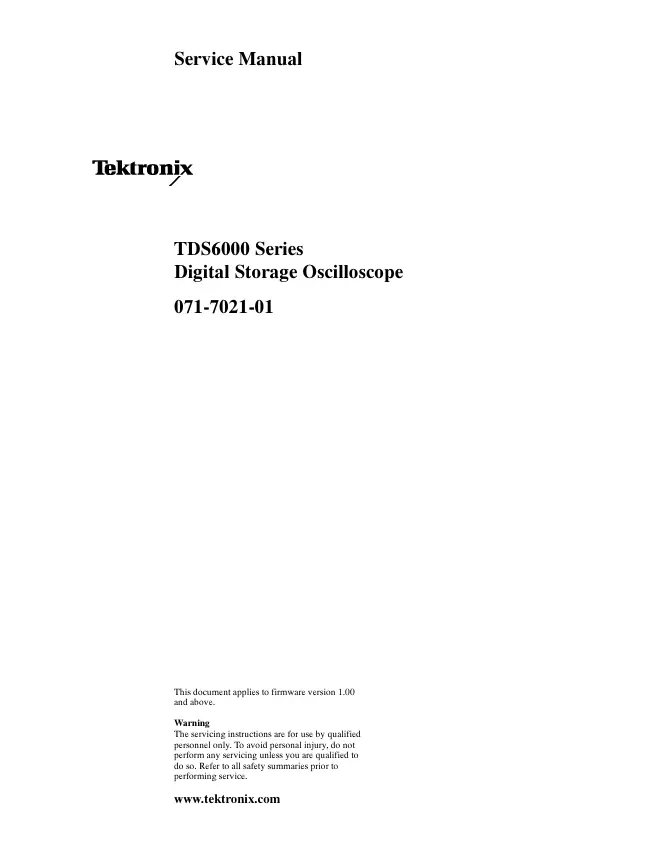Tektronix - TDS6000 - Oscilloscope
Manufacturer:
Equipment:
TDS6000
Date:
2003
Category:
Group:
Sub Group:
Information
Acquisition Features
Separate Digitizers. Ensure accurate timing measurements with separate digitizers
for each channel. Acquisition on multiple channels is always concurrent. The
digitizers can also be combined to yield a higher sample rate on a single channel.
Long Record Lengths. Record lengths from 125,000 points when using channel 1
with 2 or channel 3 with 4, or any three channels, or all 4 channels. Up to
250,000 points when using channel 1 with 3, channel 1 with 4, channel 2 with 3,
or channel 2 with 4, or any single channel.
Peak Detect Acquisition Mode. See pulses as narrow as 50 ps even at the slower
time base settings. Peak detect helps you see noise and glitches in your signal.
Acquisition Control. Acquire continuously or set up to capture single shot
acquisitions. Enable or disable optional acquisition features such as equivalent
time.
Horizontal Delay. Use delay when you want to acquire a signal at a significant
time interval after the trigger point. Toggle delay on and off to quickly compare
the signal at two different points in time.
SignalProcessing Features
Average, Envelope, and Hi Res Acquisition. Use Average acquisition mode to
remove uncorrelated noise from your signal. Use Envelope to capture and
display the maximum variation of the signal. Use Hi Res to increase vertical
resolution for lower bandwidth signals.
Waveform Math. Set up simple math waveforms using the basic arithmetic
functions or create more advanced math waveforms using the math expression
editor. Waveform expressions can even contain measurement results and other
math waveforms.
Spectral Analysis. Display spectral magnitude and phase waveforms based on
your time-domain acquisitions. Control the oscilloscope using the traditional
spectrum analyzer controls such as span and center frequency.
Display Features
Color LCD Display. Identify and differentiate waveforms easily with color coding.
Waveforms, readouts, and inputs are color matched to increase productivity and
reduce operating errors.
Zoom. To take advantage of the full resolution of the oscilloscope you can zoom
in on a waveform to see the fine details. Both vertical and horizontal zoom
functions are available.
Measurement Features
Cursors. Use cursors to take simple voltage, time, and frequency measurements.
Automatic Measurements. Choose from a large palette of amplitude, time, and
histogram measurements. You can customize the measurements by changing
reference levels or by adding measurement gating.
Trigger Features
Simple and Advanced Trigger Types. Choose simple edge trigger or choose from
eight advanced trigger types to help you capture a specific signal fault or event.
Dual Triggers. Use the A (main) trigger system alone or add the B trigger to
capture more complex events. You can use the A and B triggers together to set
up a delay-by-time or delay-by-events trigger condition.
Convenience Features
Autoset. Use Autoset to quickly set up the vertical, horizontal, and trigger
controls for a usable display.
Touch Screen Interface. You can operate all oscilloscope functions (except the
power switch) from the touch screen interface. If convenient, you can also install
a mouse and keyboard to use the interface.
Toolbar or Menu Bar. You can choose a toolbar operating mode that is optimized
for use with the touch screen, or a PC-style menu-bar operating mode that is
optimized for use with a mouse.
Open Desktop. The oscilloscope is built on a Microsoft Windows software
platform; the oscilloscope application program starts automatically when you
apply power to the instrument. You can minimize the oscilloscope application
and take full advantage of the built-in PC to run other applications. Moving
waveform images and data into other applications is as simple as a copy/paste
operation.
Dedicated Front Panel Controls. The front panel contains knobs and buttons to
provide immediate access to the most common oscilloscope controls. Separate
vertical controls are provided for each channel. The same functions are also
available through the screen interface.
Data Storage and I/O. The oscilloscope has a removeable hard disk drive, a
CD-RW drive, and a floppy disk drive that can be used for storage and retrieval
of data. The oscilloscope has GPIB, USB, Centronics, and Ethernet ports for
input and output to other devices.
Online Help. The oscilloscope has a complete online help system that covers all
its features. The help system is context sensitive; help for the displayed control
window is automatically shown if you touch the help button. Graphical aids in
the help windows assist you in getting to the information you need. You can also
access the help topics through a table of contents or index.
Service manual
Manual type:
Service manual
Pages:
252
Size:
4.3 MB
Language:
english
Revision:
Manual-ID:
071-7021-01
Date:
January 2003
Quality:
Electronic document, no scan, very well readable.
Upload date:
July 29, 2020
MD5:
f992c1fd-125d-ea43-1d52-d57d7a6ac5f2
Downloads:
300
